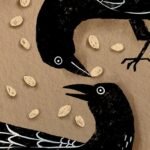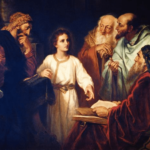[ad_1]
Luke CHAPTER 12 Jesus teaches, Beware of hypocrisy; lay up treasures in heaven rather than on earth; prepare for the coming of the Lord; where much is given, much is required; preaching the gospel causes division.
Luke CHAPTER 13 Jesus teaches, Repent or perish—He gives the parable of the barren fig tree, heals a woman on the Sabbath, and likens the kingdom of God to a mustard seed—He discusses whether few or many are saved and laments over Jerusalem.
Luke CHAPTER 14 Jesus again heals on the Sabbath—He teaches humility and gives the parable of the great supper—Those who follow Him must forsake all else.
Luke CHAPTER 15 Jesus gives the parables of the lost sheep, the piece of silver, and the prodigal son.
Luke CHAPTER 16 Jesus gives the parable of the unjust steward—He teaches of service and condemns divorce—He gives the parable of the rich man and Lazarus.
Luke CHAPTER 17 Jesus speaks of offenses, forgiveness, and faith—Even the faithful are unprofitable servants—Ten lepers are healed—Jesus discourses on the Second Coming.
John CHAPTER 11 Jesus testifies that He is the Resurrection and the Life—Mary and Martha testify of Him—He raises Lazarus from the dead—Caiaphas speaks prophetically of the death of Jesus.
Heavenly Father wants all of His children to return to Him.
The Lost Sheep

The Lost Coin

The Lost Son

Friend May 2017 “Jesus Taught About Heavenly Father’s Love” Jesus teaches about the lost coin, the lost sheep, and the prodigal son.





Come, Follow Me—For Primary: New Testament 2023 “Luke 12–17; John 11” Think about the children in your class, including those who may not attend regularly. How can you help them feel Heavenly Father’s love? How can you inspire the other children to help you reach out to them in love?
- Give one child a coin, another child a picture of a sheep, and another child a picture of the prodigal son (see ChurchofJesusChrist.org or this week’s activity page). Tell the three parables found in Luke 15 and invite the children to hold up their coin or picture when you mention it. You could invite the children to retell the parables to each other in their own words.
- Ask the children to share a time when they lost something. How did they find it? Explain that people can become lost spiritually when they don’t follow Heavenly Father. Testify that God wants people who are lost to come to Him, and we can help them.
Latter Day Kids “I Have Found That Which Was Lost” Lesson ideas
Friend March 2001 “The Good Shepherd Game” Play the game in family home evening by hiding a lamb and letting a member of the family find it. If you wish, you can bleat “baa” louder or softer as he or she gets closer to or farther from the lost lamb. If a lamb is lost, a good shepherd finds it and brings it back to the fold.
- Invite the children to think of other children who don’t come to Primary. Help them color or write notes inviting these children to attend Primary or a Primary activity. How else can we help these children feel Heavenly Father’s love for them?
Friend July 2021 “Dear Friends” I enjoyed the activity to blow the sheep to Jesus from the Come, Follow Me ideas (Sept. 2020). Ari S., age 4, Texas, USA
New Testament Coloring Book “The Prodigal Son”
For additional teaching resources and stories see Fellowshipping.
I can help Jesus find His lost sheep.
Come, Follow Me—For Primary: New Testament 2023 “Luke 12–17; John 11” We all know someone who is in some ways like the lost sheep, the lost coin, or the prodigal son in the Savior’s parables. Consider how you can inspire the children to reach out to these people with love.
- Help the children read the parable of the lost sheep or the parable of the lost coin, found in Luke 15:1–10, and share what they learned.
The Lost Sheep

The Lost Coin

The Lost Son

- Write these names on the board: father, older son, and younger son. Show the video “The Prodigal Son” (ChurchofJesusChrist.org) and pause it occasionally so the children can write on the board some of the feelings of the people listed. How do Heavenly Father and Jesus feel about those who have sinned?
New Testament Student Manual According to the customs of the Savior’s time, a son received his inheritance only after his father died. For a son to demand his inheritance before his father’s death (see Luke 15:12–13) would have been an enormous offense. The son’s request would have been seen as a rejection of his father, his home, his upbringing, and even his entire community.
New Testament Seminary Student Manual (2023) “Luke 15”
The Pharisees criticized the Savior for receiving and eating with sinners.
- What do you think the Savior hoped the Pharisees would learn from this parable?
One truth we learn from this parable is that Heavenly Father values and loves all His children and is waiting with open arms to welcome all who will turn to Him.
- Ask a child to leave the room while the other children hide a coin or paper sheep. Have the child return and look for the coin or sheep. What are some ways people can feel “lost” like the coin or the sheep? Invite the children to suggest ways they can reach out to them. Sing with the children a related song, such as “Dear to the Heart of the Shepherd” (Hymns, no. 221), and testify of the joy that comes when people return to God.
Friend March 2001 “The Good Shepherd Game” Play the game in family home evening by hiding a lamb and letting a member of the family find it. If you wish, you can bleat “baa” louder or softer as he or she gets closer to or farther from the lost lamb. If a lamb is lost, a good shepherd finds it and brings it back to the fold.
Come, Follow Me—For Individuals and Families: New Testament 2023 “Luke 12–17; John 11” Do your family members understand what it feels like to lose something—or to be lost? Talking about their experiences could start a discussion about the parables of the lost sheep and lost coin. Or you could play a game in which someone hides and other family members try to find him or her. How does this activity help us understand these parables?
- Explain that Jesus used the lost sheep, the lost coin, and the prodigal son to represent people who are “lost” because they do not have the blessings of the gospel. Invite the children to think of people they know who don’t have these blessings in their lives. What can they do to help these people feel Heavenly Father’s love for them?
Friend May 2015 “The Prodigal Son” Lesson and story ideas and crossword puzzle
Lesson 19: The Lost Sheep, the Lost Coin, and the Prodigal Son,” Primary 7: New Testament
Play Search and Find. Ask a child to think of a place where he or she could get lost and write it on a piece of paper or whisper it to the teacher. Have the other children ask “yes” or “no” questions to determine where the child is located (Is it in a crowded place? Is it in the mountains? Is it under something?). Help the children understand that it takes time and effort to find someone who is lost, especially someone who is spiritually lost.
I can show my love for Heavenly Father by being grateful for my blessings. (younger children)

Friend May 2023 “One Thankful Man”




Come, Follow Me—For Primary: New Testament 2023 “Luke 12–17; John 11” How might the story of the ten lepers encourage the children to be thankful?
- Tell the story of the ten lepers who were healed by Jesus. Show the picture found in this week’s outline in Come, Follow Me—For Individuals and Families and invite the children to count to ten on their fingers. Then ask them to put down nine fingers to show the one leper who thanked Jesus. Help the children think of someone they could thank for a kind or helpful action.
See The Red Crystal “Luke 12-17, John 11” for a ten leper finger puppet printable for this part.
- Invite each child to act out something he or she is grateful for, and have the rest of the children guess what it is. Ask the children to share ways we can show Heavenly Father that we are thankful for our blessings.
Friend May 2023 “Come, Follow Me Activities: Showing Gratitude”
Story: Read the story “One Thankful man” on page 46. How can you show gratitude?
Song: “Thanks to Our Father” (Children’s Songbook, 20)
Activity: Cut out 10 strips of paper. On each strip, write (or draw) one thing you are grateful for. Loop the strips around each other and glue or tape the ends together to make a chain. Hang your gratitude chain somewhere you will see it often.
Friend May 2023 “Come, Follow Me Activities for Little Ones”
Play this gratitude guessing game with your little ones! Choose something you’re grateful for, but don’t say what it is yet. List reasons why you are grateful for that person or thing until your child guesses correctly. Then it’s their turn!
Friend May 2023 “I Can Be Thankful”
For additional teaching ideas see Gratitude.
New Testament Coloring Book “The Ten Lepers”
Friend May 2013 “Coloring Page”
I can show my love for Heavenly Father by being grateful for my blessings. (older children)

Come, Follow Me—For Primary: New Testament 2023 “Luke 12–17; John 11” The story of the ten lepers might be a good way to inspire the children to express gratitude to Heavenly Father for their blessings.
Leprosy, more common anciently than today, is a skin disease that can lead to physical disfiguration and death. In biblical times, people with leprosy were separated from the rest of society and were required to call out “Unclean!” to warn anyone approaching them (see Bible Dictionary, “ Leper,” “ Leprosy ”).
Gospel Art Picture: “The Ten Lepers”
- Read together the account of the ten lepers. How was the leper who gave thanks blessed for his gratitude? Why is it important to thank God for our blessings?
The Lord often blesses us more if we are grateful for what He has already given us.
Friend April 2019 “God’s Great Gift” President Nelson asked the person who daily fed some tropical fish if they had ever thanked her. He says that some people are like those fish. They are not aware of God and His goodness to them.
- Invite the children to list things they are grateful for that start with each letter of their name.
Friend November 2017 “Family Night Fun” Ways you can look for blessings every day.
“Lesson 24: I Can Show Gratitude,” Primary 2: Choose the Right A
Display the empty cup, the spoon, and the container of water. Ask the children to think of the many blessings Heavenly Father has given them, and explain that each time they name a blessing they may take a spoonful of water from the container and put it into the cup.
Place the cup and the container of water in the pan or dish to catch spills, and place the pan or dish on a flat surface such as the table or floor.
You may want to use the following questions to help the children think of their blessings:
- What are some of the beautiful creations Heavenly Father has given us?
- Who are some special people he has blessed us with?
- What things can our wonderful bodies do?
Have the children take turns naming blessings and putting spoonfuls of water in the cup until the cup is filled to overflowing. Explain that Heavenly Father loves us and has given us many blessings. When we think of these blessings, we are thankful and filled with love for Heavenly Father. Heavenly Father has given us so many blessings that we can overflow with love, just like the cup overflowed with water.
- Ask the children to write thank-you notes to Heavenly Father for the blessings He gives them. They could hang the notes by their beds to remind them to express gratitude when they pray.
For additional teaching ideas see the following:
“Lesson 25: Remember to Say ‘Thank You’” Primary 2: Choose the Right A
“Lesson 21: Jesus Christ Heals Ten Lepers,” Primary 7: New Testament
News with Naylors “Week 19: The Ten Lepers (gratitude)” Has a fun M&M gratitude activity.
We believe that Jesus is the Son of God. (younger children)
Come, Follow Me—For Primary: New Testament 2023 “Luke 12–17; John 11” Martha, who was Lazarus’s sister, told Jesus: “I believe that thou art the Christ, the Son of God” (John 11:27). The story of Mary, Martha, and Lazarus can strengthen the children’s testimonies of Jesus Christ.

Friend April 2023 “Jesus Raises Lazarus from the Dead”


- Show the children a dead branch and a living plant, and ask them which one is dead and which one is living. Bear your testimony that because of the power of Jesus Christ, people who are dead will be resurrected and live forever.


- Help the children memorize the phrase that Jesus said to Martha: “I am the resurrection, and the life” (John 11:25). Explain that because of the Savior’s Resurrection, we will once again see our loved ones who have died.
We believe that Jesus is the Son of God. (older children)

Come, Follow Me—For Primary: New Testament 2023 “Luke 12–17; John 11” How can you use the story of Mary, Martha, and Lazarus to help the children know, as Martha did, that Jesus is “the Christ, the Son of God”? (John 11:27).
- Write on the board some statements spoken by people in John 11. Ask the children to identify who said each statement, and invite them to search John 11 to check their answers. How would they feel if they were Jesus, Martha, Mary, or Lazarus? How can believing in Jesus help us when we are sad or scared?
See The Red Crystal “Luke 12-17, John 11” for a printable of different statements found in John 11.
- Read Martha’s testimony, found in John 11:20–27. Ask the children to look for words and phrases that show that Martha had faith in Jesus Christ. What can we do to have faith in Him?
Ensign April 2001 “Increasing Our Faith in Jesus Christ”
We study and practice to develop the skills we need in any earthly endeavor. So also do we develop faith. “Faith cometh by hearing, and hearing by the word of God,” the Apostle Paul explains (Rom. 10:17). Elder Henry B. Eyring of the Quorum of the Twelve Apostles observes that “simply hearing the words of doctrine can plant the seed of faith in the heart. And even a tiny seed of faith in Jesus Christ invites the Spirit” (“The Power of Teaching Doctrine,” Ensign, May 1999, 74).
Once the seed of faith has been planted in our hearts, it must be nourished. Our faith in Jesus Christ is nourished as we study, search, and ponder the scriptures; fast and pray; participate in sacred ordinances; keep our covenants; serve the Lord and others; sustain our Church leaders; and obey the commandments.
Friend January 1999 “Faith in Jesus Christ”
As our faith in Jesus Christ grows stronger, we learn to walk with faith in Him. “To have faith in Christ,” says Sister Sheri L. Dew, second counselor in the Relief Society general presidency, “is to believe in Him, follow Him, and rely on Him. And it is to be blessed with the peace of conscience and mind that the Apostle Paul spoke of when he said, ‘I can do all things through Christ which strengtheneth me’” (Philip. 4:13) (“Our Only Chance,” Ensign, May 1999, 67).
Also see Family Home Evening Resource Book “My Faith in Christ Can Grow”
- Help the children memorize John 11:25. Explain that everyone will be resurrected, but only the righteous will receive eternal life and live with Heavenly Father and Jesus Christ again.
New Testament Coloring Book “Jesus Raised Lazarus from the Dead”
Lesson 28: Jesus Christ Raises Lazarus from the Dead,” Primary 7: New Testament
Additional Resources
The Red Crystal “Luke 12-17, John 11” Lesson ideas
Come Follow Me with Living Scriptures “Welcome Home” Lesson ideas
Please follow and like us:
[ad_2]
Source link


























You must be logged in to post a comment.